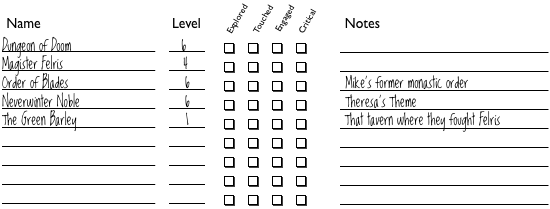What we want in a game is a lot like what we want in life. I’m gonna riff a bit here on David McClelland via Peter Bregman with the list of desires that drive us:
- Achievement (To compete against increasingly challenging goals)
- Affiliation (To be liked/loved)
- Personalized power (influence and respect for yourself)
- Socialized Power (to offer others Personalized power, which is to say, influence and respect)
This list speaks a lot to how much our jobs and lives are going to satisfy us, and it’s no coincidence that the list also reads like a checklist of things that players want in play in an RPG (both in game and out of game).
Now, there’s no one point I want to make from this, mostly because I think there are dozens of points to be made from it, so it’s important to me to lay this out as a foundation, because it makes subsequent points easier to discuss, so with that in mind, let’s run through these.
Achievement
Achievement is probably the most obvious, since it lies at the heart of the game part of most games, and it’s intimately tied to things like advancement, encounter design and so on. It’s important to call out that there’s a reason this is achievement, not challenge, because challenge is only a part of it – it’s the increase that is truly critical. Our brains thrive on mastery – we get a buzz from learning things and overcoming difficulty, but only the first time. If we’re faced with the same problem again, it quickly bores us. If we’re faced with an utterly different problem, that might be fun, but the sense of progress is not there. It’s counter-intuitive, but the best reward for success is a greater challenge.
This is one reason we’re so attached to character advancement in games, because it’s the easiest way for a GM to ramp up challenge. Without advancement, the GM needs to either push harder every time (as you would in a non-RPG as you progress in competitive ranks) or get very creative.
Now, I should note that there’s a lot of leeway in terms of what the challenge is, and that interacts pretty strongly with what Achievement needs. Fight scenes are challenges, and they’re the sort of challenges that advancement speaks to, but if the challenge the player seeks is creative, that requires a very different sort of ratcheting effect to keep increasing challenge.
Affiliation
Hopefully, this is largely obvious – it’s a big reason we play these games rather than write fiction to similar effect. The social element of play is huge, and not to be underestimated.
However, in my experience this is also a big part of satisfaction in play. One of the rules of design behind a lot of Evil hat decisions is that everything should have a face. Settings are made most interesting by the imaginary people in them, because the fact that they’re imaginary doesn’t really keep us from forming strong attachments to them (as can be evinced by the message boards of any fandom). Play that provides opportunities to scratch the affiliation itch is going to be satisfying play.
Personalized Power
Well, duh.
Ok, maybe it’s a little more complicated than that – step back a minute and consider what power means. It means the capability to accomplish things, to make things happen. It’s the ability for your action to have a measurable, noticeable outcome. It’s the ability to shape the world through your actions. When we have this power, it is a great feeling, and when we are denied it, it can be frustrating beyond measure.
Now, the first instinct is to look at RPG characters and drawl a line to their obvious power. Throwing lightning bolts, lifting cars and cutting through hordes of monsters are such clear expressions of power that they’re the first thing the mind goes to, but in doing so, it misses the mark. Certainly, that sort of blatant power is fun, but it is not in and of itself satisfying.
The real power of an RPG character is the ability to act. Part of this is implicit in the structure of rules (you roll the dice and something is going to happen) and some of it is implicit in adventure design (it’s a poor adventure where there’s not much to do) but taken as a whole, it’s an ability to simply do things which we often lack in our day to day lives. In real life, there are complication. Doing things is slow and boring, or our situation may not allow us to impact things that matter to us. In games, we can act. We may not always succeed, but just being able to try is empowering.
Lightning bolts and flaming swords just make that ability to act more colorful. It’s the action that is power.
Socialized Power
This one is probably the most interesting because while it’s probably the most poorly served by games in general, it’s possibly the most powerful when a game makes it go, because in play it’s most often reflected by as making other people awesome, which is (to my mind) one of the best things that can happen at a table.
The real meaning of this is something that could take up multiple posts of its own, but one interesting thing about socialized power is that it is hard to do without affiliation and personalized power, since it’s the fruitful combination of the two (it’s possible, but doing so tends to be more like martyrdom than a healthy dynamic). As a result, it can take more work to achieve, and it’s benefits are probably the least obvious until you have tasted them.
There’s more to say, but at this point it starts turning to how these points interact with games at the table, and that’s fodder for future posts.

